CUSTOMER SPOTLIGHT: CODY LINDSEY’S RIGHT-HAND-DRIVE BIG BLOCK CHEVETTE
I’m interested in metal fabrication and artwork. I consider cars the landscape.
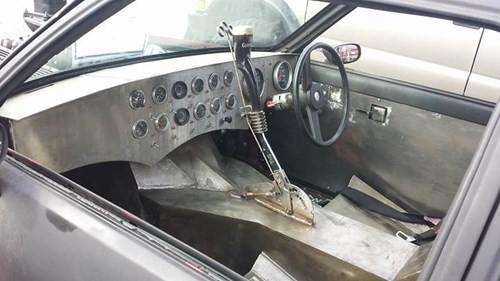
Ever had your doors blown off by a Chevette? Next time you see one in the wild, don’t make fun — it could be Cody Lindsey’s daily-driven hatchback, stuffed with a 454 big block up front and twin Guinness kegs in back.
“Everybody goes to build a Camaro or Corvette,” Lindsey said on a recent trip to Pull-A-Part with his brother and their girlfriends, who are no strangers to a wrench. “These are cheap and easy to come by. I bought two identical Chevettes that had been in a barn. Every year, this guy would buy his daughters a new car. When his twin daughters turned 16, he gave them these — and they said they’d rather walk than be seen in them. They both ran after a tuneup. My third one I just found on Craigslist when I decided I wanted to build a fast Chevette.”
Why wouldn’t a right-hand-drive Chevette have a Guinness ratchet shifter?
Factory figures rated the Chevette, which Lindsey describes as afflicted by a stigma “for being terrible”, at 65 horsepower. His vision of bringing the rear-drive econobox to glory turned into a journey toward 650 horsepower — which he said would be a “cool, epic thing”.
“Right now, my car has a stock 454 in it, with a rear-mounted radiator,” Lindsey said. “It has power rack-and-pinion steering from a ‘98 Chevy Beretta.”
That’s where Lindsey’s story turns from comical to technical.
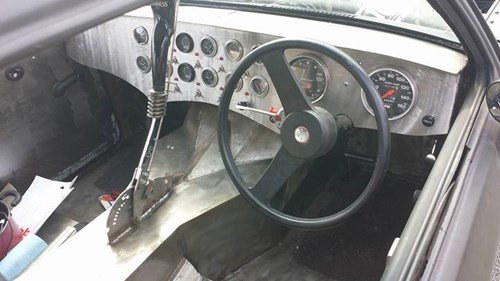
Lindsey pieced together the correct subframe, suspension and steering components to bring his RHD Chevette to life.
“I wanted to run Chevy metric brakes, because they’re cheap and simple, and you can always get conversion kits for them,” Lindsey said. “Also, tubular A-arms are cheaper than everything else out there. So I picked up a Chevy S-10 K-member with a link-steering system. You can’t chop three inches out of a link, so I had to pick a rack-and-pinion system. In order to establish how wide your rack and pinion you need, you have to draw an imaginary line between your upper and lower A-arms to tell you where your inner tie rods should be to stop bump steer. When I did that, I came up with 15 inches — there’s no rack and pinion in the world that’s only 15 inches wide. I looked up a universal rack and pinion that was about $1000 — I didn’t want to pay that for a single part, so I went looking for the shortest box I could find. The Beretta rack has a slit in the middle so the tie rod ends bolt directly onto the face of the rack. The ends are capped off. I just bolted a plate on there, put in some cam followers to keep it from rolling back and forth, and put my inner tie rods wherever I wanted. I built a whole mounting bracket and everything for it. I made the front tie rods out of 4142 steel bar — just spun them on a lathe and tapped them for heim joints.”
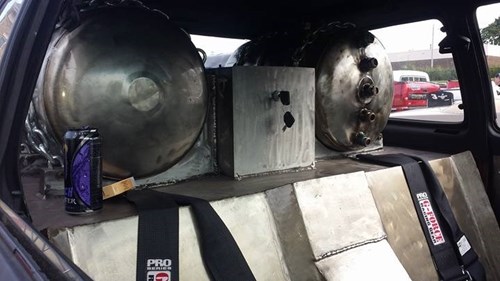
Two of the big ones: we didn’t ask if they were actually filled.
Bits and pieces — but not the kegs — were sourced from Pull-A-Part.
“The hilarity of the Chevy Beretta is that it’s a rear-steer rack-and-pinion, mounted behind the axle line up against the axle lines,” Lindsey said. “S10s are front-steer link-steering, which means the knuckle which I wanted to keep sits out front when you go to turn the input shaft for the rack and pinion, the rack actually goes the opposite way. So you have to flip it upside down to make it work.”
The setup works so well, in fact, that it is driven on the street when Lindsey is not driving his two other Chevettes — two cars in great condition that are admittedly closer to stock.
Meet Cody
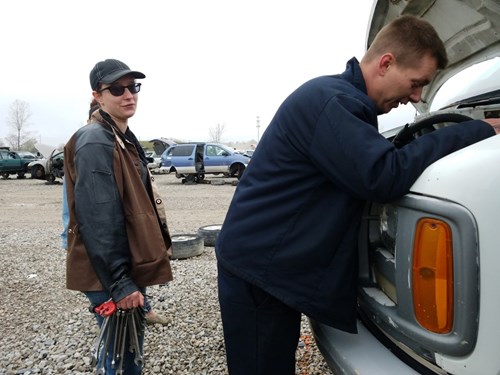
Cody and his girlfriend like to spend time wrenching, finding the exact part for their custom builds. Here, he’s excited because he just found the perfect part: a hydroboost system for his Chevette.
Home yard: Pull-A-Part Cleveland
Why Pull-A-Part: I’m building custom cars. It’s hard to look up information and statistics, like what diameter radiator hoses each engine came with. You’d have to spend hours on the Internet. Craigslist is sketchy, and when you do find something on there, everyone thinks it’s super valuable. Here, if I hunt for radiator hoses I use for modification or fabrication, I get all the bends, shapes and forms I can use. I can go home with a bucket full of hoses that costs $25. To buy general purpose radiator hose material at a store is like $12 a foot. If you can come here and pull radiator hoses off ten different cars and pay about five bucks apiece, you can use them on almost anything you want.
If you’re looking for a part off a car, you can walk around for a couple of hours and just look and say, this one has this style, this one has that style.
Cody and his brother begin to tackle the hydroboost system removal.
When another salvage yard removes the part themselves, they sometimes damage the parts, mess it up or it’s been banged around awhile. I went through three heads from other salvage yards. They all had cracks and a huge ding in them because the guy who took them off was throwing it in a bucket. Here, if you take it off, you get to see what the engine looks like when you take it off — you can get a sense of the coolant and oil. Was it a blown head gasket? If so, don’t even bother, just go to another one. Was it brought here for front end damage or was it brought here because there’s a rod through the block? At other salvage yards, they just hand you the part — you have no idea what was wrong with it.
Favorite car: I have a C/K 1500 that’s tubbed and lowered at home. It was my first car ever at the age of 15. It had a big block, narrowed rear end, 15 inch-wide tires. That has to be my favorite — a square-body Chevy pro-street lowrider.
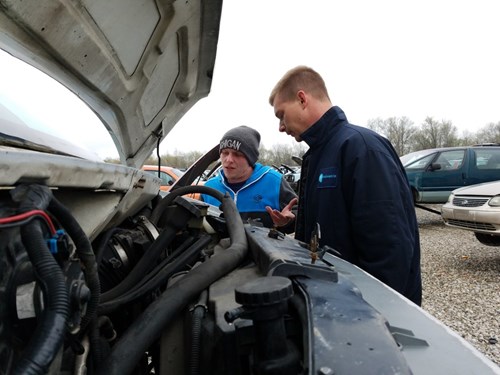
Cody and his friends recovered a hydroboost system from a Chevrolet Express during their trip to the yard.
When another salvage yard removes the part themselves, they sometimes damage the parts, mess it up or it’s been banged around awhile. I went through three heads from other salvage yards. They all had cracks and a huge ding in them because the guy who took them off was throwing it in a bucket. Here, if you take it off, you get to see what the engine looks like when you take it off — you can get a sense of the coolant and oil. Was it a blown head gasket? If so, don’t even bother, just go to another one. Was it brought here for front end damage or was it brought here because there’s a rod through the block? At other salvage yards, they just hand you the part — you have no idea what was wrong with it.

Favorite car: I have a C/K 1500 that’s tubbed and lowered at home. It was my first car ever at the age of 15. It had a big block, narrowed rear end, 15 inch-wide tires. That has to be my favorite — a square-body Chevy pro-street lowrider.
THERE'S MORE TO PULL-A-PART THAN CHEAP USED AUTO PARTS